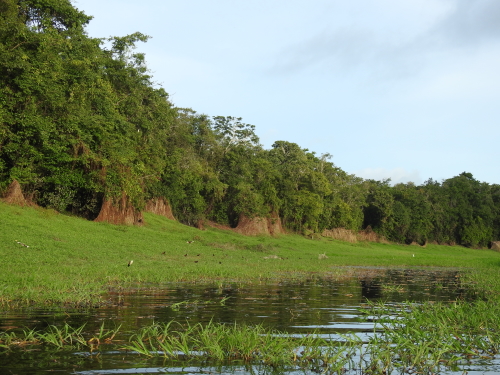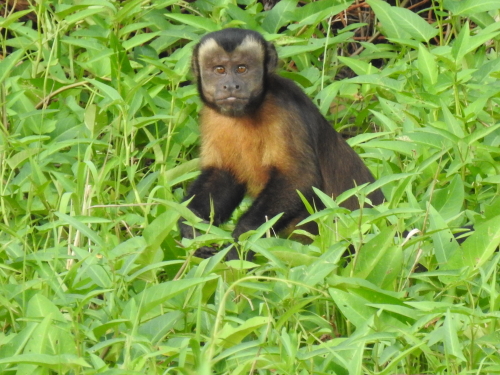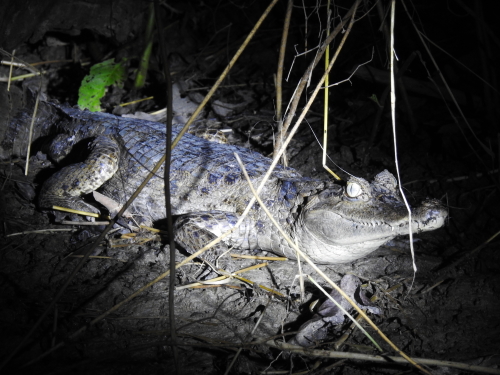Blog WHS Visits
WHS #811: Central Amazon
The Central Amazon Conservation Complex is a mostly contiguous area of parks and reserves in the northwest of Brazil, approximately in the center of the Amazon biome and the Amazon basin. You can dip your toe in with a one-day tour to Anavilhanas from the state capital of Manaus, but I opted for a more substantial visit to the sublocation ‘Marimaua Reserve’. Situated over 500km west of Manaus, I first had to fly to Tefé. This is a bustling river port of 60,000 inhabitants with no road access. I was picked up for another 1.5 hours of travel by boat to the Uakari Lodge, where I stayed for 3 nights inside the Reserve.
The OUV of Marimaua lies mainly in conserving a varzea forest, seasonally flooded by fertile “whitewater” rivers flowing from the Andes region. On our first day, we got to see which effect the floodings have on the local flora and fauna. We visited an island where the difference in water level can be up to 12 meters. The habitat is only suited to animals that can fly, swim or live in trees. You won’t find any tapirs or capybaras here…. Even the ants and termites build their nests high up in the trees instead of on the ground. Jaguars survive also up in the trees, but they are half the size of their cousins elsewhere.
The seasonal rise in water levels has an impact on the local people too. Mamirauá is inhabited by 14 small ribeirinho communities. To cope with the flooding, the people live in houses on stilts. They have floating gardens and floating solar panels to keep these amenities available throughout the year. At one village they told us that they yearly sell or eat almost all of their chickens before the rainy season begins (as the chickens can’t fly or swim). The floodings also deposit a lot of sand, so the beach gets bigger each year and the houses get situated further from the river. The local people use the beach to grow beans and watermelons. They also rescue the eggs of turtles and bring them to the restricted area of Lake Marimaua after they have hatched.
Mamiraua also is a Fish WHS: its flagship species is the “pirarucu” (Arapaima), the largest freshwater fish in South America. Furthermore, there are two species of river dolphins: pink and grey. And there are 64 species of electric fish, “the strongest known diversity for this group unique in the world”. The dolphins are easy to see on the river between Tefé and the entrance to the Reserve – but hard to photograph as always. The arapaima were jumping up and down all day in front of my cabin at the (floating) lodge. Other guests at the lodge had come for a week of sport fishing and they apparently had a blast.
My main interest however was with the mammal life in the reserve, and I was not disappointed either. We did 2 hikes and 2 boat tours, which gave us sufficient time on the ground/on the water to see all main mammal species except for the very rare ones such as the jaguar. Mamirua has two species of monkey that cannot be found elsewhere in the world anymore: the black squirrel monkey (similar to the common one, but with black hair on its head) and the intriguing white uakari. The uakari has fully white fur and a bright red face – it doesn’t look like any other monkey, it’s almost like an albino. We were lucky to see one during the boat tour to Lake Mamiraua, in the heart of the reserve. Although the sighting was short, the animal showed its fluffy body well by walking on a leafless branch. And it turned its head to show its red face. On the long walk on day 3, we encountered a group of uakaris in the forest, but there they were harder to see (just a white limb here and there).
Due to the seasonal nature of this site, a visit in May (right at the end of the rainy season when the water level is at its highest) will be totally different from one in November. In the dry season, the caimans and birds thrive on the fish that are then confined to a smaller area. In the wet season, you have a better chance of observing mammals as they have to resort to the trees.
The history of the Mamiraua Reserve and the Uakari Lodge is fascinating as well. The reserve started in 1986 to protect the uakari. Quickly however it became clear that the local people would have no space anymore to fish and cultivate the land to sustain their livelihoods. So the reserve was turned into a mixed-use area, where local people may extract resources on a sustainable basis and ecotourism has its place. It is governed by an elaborate community-based management system. People from the 14 communities work at the lodge and perform patrol duties on the river, and each community yearly receives a share of the income from the lodge to spend on projects. With this approach, they have managed to stop illegal logging and fishing.
A final thought: I wonder why this hasn’t been inscribed on cultural criteria as well. The people have adapted their lifestyle to the seasonal flooding too, as described above. Also, the area is clearly impacted by human use, ever since the rubber boom of the early 1900s attracted significant numbers of people from other parts of Brazil to work here. Brazil’s nomination file also describes its proposal as a cultural landscape, but there seems to have been no follow-up by ICOMOS. I recommend reading ‘Tree of Rivers: The Story of the Amazon’ by John Hemming about the fascinating human history of Brazil’s Amazonia.
Els - 4 December 2022


